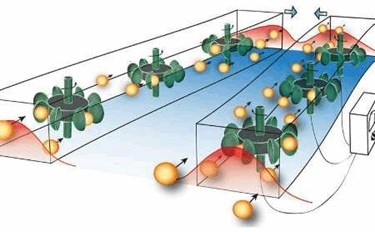The Optical Force Is Strong With This One
By Jof Enriquez,
Follow me on Twitter @jofenriq

A team of European physicists recently presented a new approach to manipulating photons flowing inside metamaterial waveguides in order to strengthen the optical force between them. The new design could someday find its way into highly-advanced optical sensors and nanomotors.
Optical forces between light beams that run parallel to each other within adjacent waveguides either cause the beams to attract or repel each other. Theoretically, this phenomenon can be useful in a myriad of applications, such as sensing devices. So far, however, scientists have observed that these optical forces are too weak to be useful for the convenient actuation of integrated switches and waveguide couplers.
Now, researchers at Chalmers University of Technology and Free University of Brussels have come up with a new method to enhance the optical force between waveguides by an order of magnitude through the use of gauge materials inside two evanescently coupled waveguides.
"We have found a way to trick the photons so that they cluster together at the inner sides of the waveguides. Photons normally don't prefer left or right, but our metamaterial creates exactly that effect," says Philippe Tassin, Associate Professor at the Department of Physics at Chalmers University of Technology.
As photons enter one end of a waveguide, the gauge materials inside the core of the waveguide direct and gather all photons to one side, so that they point perpendicularly to the waveguide plane.
"Depending on the relative orientation of the vector potentials in neighboring waveguides (i.e., pointing away from or towards each other), the conventional attractive force due to an even mode profile may be enhanced, suppressed, or may even become repulsive," explained Prof. Tassin and co-authors Lana Descheemaeker, Vincent Ginis, Sophie Viaene, in the Sept. 27, 2017 issue of Physical Review Letters.
When the photons inside the waveguides were manipulated to attract each other, the optical force between the waveguides was enhanced up to 10 times.
The researchers predict that their metamaterial waveguide approach will one day be used to operate sensors, or to drive nanomotors that can sort cells or particles.
"Our method opens up new opportunities for the use of waveguides in a range of technical applications. It is really exciting that man-made materials can change the basic characteristics of light propagation so dramatically," says Ginis, assistant professor at the Department of Physics at Free University of Brussels.
Several groups are experimenting with atypical waveguide designs and unique metamaterials to manipulate light and shrink waveguides, which are essential components of optical systems, but are often overlooked in favor of the devices that contain them.
